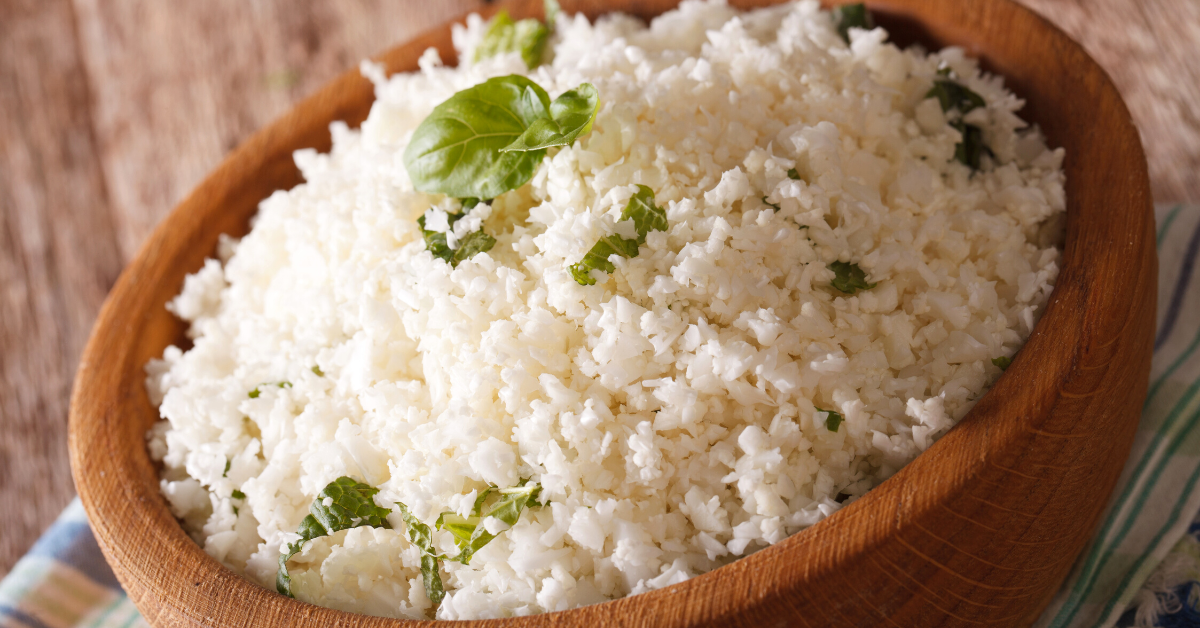
Rice. It's a simple, versatile, yet carb-heavy food. Here's an alternative for the blood-sugar conscious. Make cauliflower rice in 4 steps.
White rice is great. It's the base of so many wonderful dishes that are flavorful, nutritious and satisfying. But using rice as your base will load you up with over 50 grams of carbohydrate and an insignificant amount of fiber, based on a 1 cup serving. For many people, that's totally fine. But for those of us who are trying to manage blood sugar, whether with diet or medications, there is another option. Riced cauliflower.
A 1 cup serving of cauliflower rice gives you about 5 grams of carbs with 2 grams of those carbs being fiber, reducing the net carbs to about 3 grams. That's a huge difference for fellow carb-counters.
Cauliflower can be used as diversely as rice. So much so that it can replace it in many rice-based dishes, like rice bowls and orange chicken. And it's not difficult to make. Here's a simple way to make cauliflower rice using a food processor.
Ingredients: a large head of cauliflower and 1 TBSP of cooking oil. That's about it! After it's made add salt, pepper, or other seasonings as you'd like depending on what you're doing with it. One large cauliflower will yield 4 servings of 1 cup per serving.
Directions: Make riced cauliflower in 4 steps.
- Wash and dry the cauliflower, and remove anything green.
- Cut cauliflower into small florets. Press dry with paper towels to remove excess moisture.
- Grate the florets using the grater attachment in your food processor. The results should give you roughly rice grain-sized pieces.
- Heat 1 TBSP of cooking oil in a large skillet (medium heat) and sauté for 5 minutes. If you want the cauliflower a bit softer, cover and allow it to steam for a couple of minutes. Be careful not to over-steam. It can become mushy.
Nutritional Information: For 1 cup serving
- Calories: 25
- Fat: 0.3g
- Cholesterol: 0mg
- Sodium: 30mg
- Potassium: 299mg
- Total Carbohydrates: 5g
- Dietary Fiber: 2g
- Total Sugars: 2g
- Protein: 2g
- Vitamin C: 80% recommended daily value (DV)
- Calcium: 2% DV
- Iron: 2% DV
Quick tip: You can actually freeze uncooked cauliflower to use later. After step 2, cook only what you need and place the rest in a freezer bag or freezer-safe glass dish. It keeps up to a month. Or, you can keep the unused raw cauliflower sealed in your refrigerator up to a couple of days to use as needed for meals. Enjoy!
Some Facts About Cauliflower
Cauliflower is often thought of as a white vegetable, which is one reason it works so well as a rice substitute. Cauliflower doesn’t only come in white, rather there are varieties that are purple, orange and green. These varieties not only provide a different “look,” but some colored varieties have increased nutrients. For example, orange cauliflower has more Vitamin A compared to white cauliflower. If you want to try something different, try making cauliflower rice from one of the colored varieties. The new colored varieties also have fun names like purple Graffiti, orange Cheddar and green Romanesco.
Cauliflower is low in starch, which makes it a great choice for people managing diabetes. Starchy foods can spike blood sugar, so choosing vegetables low in starch (like cabbage, cauliflower, spinach, kale, and broccoli) provides about half the carbohydrates as starchy vegetables like potatoes. Carbohydrates are important to monitor when you are living with diabetes because your body breaks carbohydrates down into glucose. By choosing low carbohydrate options for your favorite dishes, you can better manage your glucose levels while eating the foods you love.
Cauliflower contains cancer-fighting compounds. The names of these nutrients are hard to pronounce (glucosinolates), but they help reduce inflammation in the body and hinder growth of cancerous cells.
Cauliflower is a good source of antioxidants (like all cruciferous vegetables). Antioxidants help keep inflammation in check, which can be a problem for people living with diabetes. People with type 2 diabetes becomes less sensitive to insulin. Insulin resistance often leads to inflammation, which can cause additional insulin resistance, a cycle to definitely avoid.
Cauliflower is a good source of fiber. Fiber helps manage blood sugar by slowing digestion of carbohydrates and sugar absorption into your blood, promoting a more gradual rise in blood sugar.
Cauliflower is low in calories — about 25 calories per cup as you can see in the nutrition information for this dish.
Cauliflower is packed with nutrients. In fact, cauliflower contains at least some of almost every vitamin and mineral your body needs. Some of the highlights in each one cup serving include:
- 80 percent of the recommended daily allowance (RDI) for Vitamin C, which is necessary for growth, repair, and development of your body’s tissues.
- 20 percent of the RDI for Vitamin K which plays a key role in blood clotting.
- 11 percent of the RDI for Vitamin B6 which is important in keeping your nervous and immune systems healthy.
- 14 percent of the RDI for folate which is important in the formation of red blood cells and for healthy cell growth.
Give cauliflower rice a try. You might find you even prefer it over regular rice!
This recipe is easy to make and has the added benefit of fresh ingredients. Enjoy!
